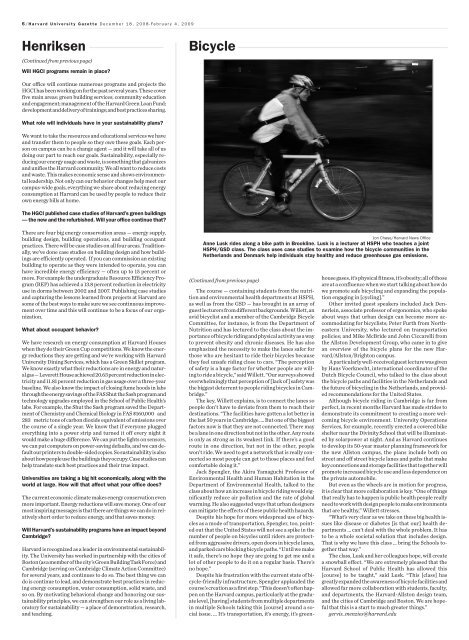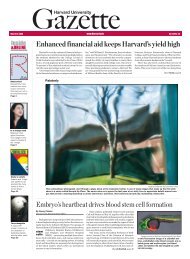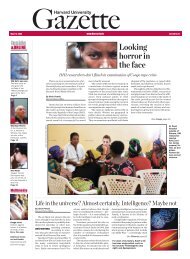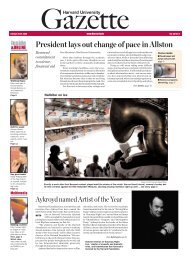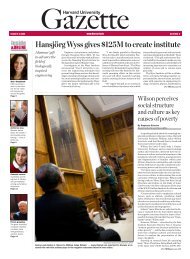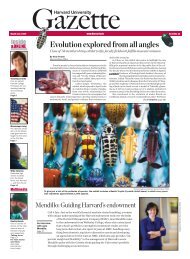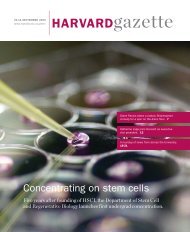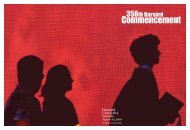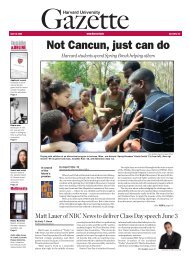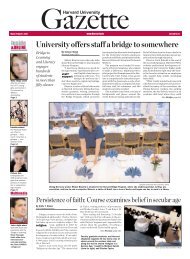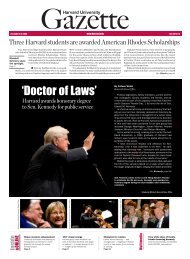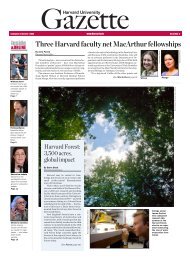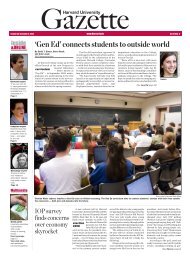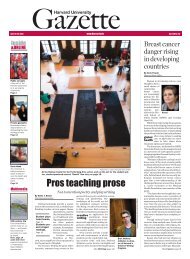Lawrence Lessig receives two Harvard appointments
Lawrence Lessig receives two Harvard appointments
Lawrence Lessig receives two Harvard appointments
- No tags were found...
Create successful ePaper yourself
Turn your PDF publications into a flip-book with our unique Google optimized e-Paper software.
6 / <strong>Harvard</strong> University Gazette December 18, 2008-February 4, 2009Henriksen(Continued from previous page)Will HGCI programs remain in place?BicycleOur office will continue numerous programs and projects theHGCI has been working on for the past several years. These coverfive main areas: green building services; community educationand engagement; management of the <strong>Harvard</strong> Green Loan Fund;development and delivery of trainings; and best practices sharing.What role will individuals have in your sustainability plans?We want to take the resources and educational services we haveand transfer them to people so they own these goals. Each personon campus can be a change agent — and it will take all of usdoing our part to reach our goals. Sustainability, especially reducingour energy usage and waste, is something that galvanizesand unifies the <strong>Harvard</strong> community. We all want to reduce costsand waste. This makes economic sense and shows environmentalleadership. Not only can our behavior changes help meet ourcampus-wide goals, everything we share about reducing energyconsumption at <strong>Harvard</strong> can be used by people to reduce theirown energy bills at home.The HGCI published case studies of <strong>Harvard</strong>’s green buildings— the new and the refurbished. Will your office continue that?There are four big energy conservation areas — energy supply,building design, building operations, and building occupantpractices. There will be case studies on all four areas. Traditionally,we’ve done case studies on building design and how buildingsare efficiently operated. If you can commission an existingbuilding to operate as they were intended to operate, you canhave incredible energy efficiency — often up to 15 percent ormore. For example the undergraduate Resource Efficiency Program(REP) has achieved a 13.8 percent reduction in electricityuse in dorms between 2002 and 2007. Publishing case studiesand capturing the lessons learned from projects at <strong>Harvard</strong> aresome of the best ways to make sure we see continuous improvementover time and this will continue to be a focus of our organization.What about occupant behavior?We have research on energy consumption at <strong>Harvard</strong> Houseswhen they do their Green Cup competitions. We know the energyreductions they are getting and we’re working with <strong>Harvard</strong>University Dining Services, which has a Green Skillet program.We know exactly what their reductions are in energy and naturalgas — Leverett House achieved 20.63 percent reduction in electricityand 11.81 percent reduction in gas usage over a three-yearbaseline. We also know the impact of closing fume hoods in labsthrough the energy savings of the FAS Shut the Sash program andtechnology upgrades employed in the School of Public Health’slabs. For example, the Shut the Sash program saved the Departmentof Chemistry and Chemical Biology in FAS $160,000 and283 metric tons of carbon dioxide equivalent of emissions overthe course of a single year. We know that if everyone pluggedeverything into a power strip and turned it off every night i<strong>two</strong>uld make a huge difference. We can put the lights on sensors,we can put computers on power-saving defaults, and we can defaultour printers to double-sided copies. So sustainability is alsoabout how people use the buildings they occupy. Case studies canhelp translate such best practices and their true impact.Universities are taking a big hit economically, along with theworld at large. How will that affect what your office does?The current economic climate makes energy conservation evenmore important. Energy reductions will save money. One of ourmost inspiring messages is that there are things we can do in relativelyshort order to reduce energy, and that saves money.Will <strong>Harvard</strong>’s sustainability programs have an impact beyondCambridge?<strong>Harvard</strong> is recognized as a leader in environmental sustainability.The University has worked in partnership with the cities ofBoston (as a member of the city’s Green Building Task Force) andCambridge (serving on Cambridge Climate Action Committee)for several years, and continues to do so. The best thing we cando is continue to lead, and demonstrate best practices in reducingenergy consumption, water consumption, solid waste, andso on. By motivating behavioral change and honoring our sustainabilityprinciples, we can strengthen our role as a living laboratoryfor sustainability — a place of demonstration, research,and teaching.Jon Chase/<strong>Harvard</strong> News OfficeAnne Lusk rides along a bike path in Brookline. Lusk is a lecturer at HSPH who teaches a jointHSPH/GSD class. The class uses case studies to examine how the bicycle communities in theNetherlands and Denmark help individuals stay healthy and reduce greenhouse gas emissions.(Continued from previous page)The course — containing students from the nutritionand environmental health departments at HSPH,as well as from the GSD — has brought in an array ofguest lecturers from different backgrounds. Willett, anavid bicyclist and a member of the Cambridge BicycleCommittee, for instance, is from the Department ofNutrition and has lectured to the class about the importanceof bicycle riding and physical activity as a wayto prevent obesity and chronic diseases. He has alsoemphasized the necessity to make the lanes safer forthose who are hesitant to ride their bicycles becausethey feel unsafe riding close to cars. “The perceptionof safety is a huge factor for whether people are willingto ride a bicycle,” said Willett. “Our surveys showedoverwhelmingly that perception of [lack of ] safety wasthe biggest deterrent to people riding bicycles in Cambridge.”The key, Willett explains, is to connect the lanes sopeople don’t have to deviate from them to reach theirdestinations. “The facilities have gotten a lot better inthe last 50 years in Cambridge. … But one of the biggestfactors now is that they are not connected. There maybe a lane in one direction but not in the other. Any routeis only as strong as its weakest link. If there’s a goodroute in one direction, but not in the other, peoplewon’t ride. We need to get a ne<strong>two</strong>rk that is really connectedso most people can get to those places and feelcomfortable doing it.”Jack Spengler, the Akira Yamaguchi Professor ofEnvironmental Health and Human Habitation in theDepartment of Environmental Health, talked to theclass about how an increase in bicycle riding would significantlyreduce air pollution and the rate of globalwarming. He also suggested ways that urban designerscan mitigate the effects of these public health hazards.Despite his hope for more widespread use of bicyclesas a mode of transportation, Spengler, too, pointedout that the United States will not see a spike in thenumber of people on bicycles until riders are protectedfrom aggressive drivers, open doors in bicycle lanes,and parked cars blocking bicycle paths. “Until we makeit safe, there’s no hope they are going to get me and alot of other people to do it on a regular basis. There’sno hope.”Despite his frustration with the current state of bicycle-friendlyinfrastructure, Spengler applauded thecourse’s creation as a first step. “This doesn’t often happenon the <strong>Harvard</strong> campus, particularly at the graduatelevel, [having] students from multiple departmentsin multiple Schools taking this [course] around a socialissue. … It’s transportation, it’s energy, it’s greenhousegases, it’s physical fitness, it’s obesity; all of thoseare at a confluence when we start talking about how dowe promote safe bicycling and expanding the populationengaging in [cycling].”Other invited guest speakers included Jack Dennerlein,associate professor of ergonomics, who spokeabout ways that urban design can become more accommodatingfor bicyclists; Peter Furth from NortheasternUniversity, who lectured on transportationpolicies; and Mike McBride and John Ciccarelli fromthe Allston Development Group, who came in to givean overview of the bicycle plans for the new <strong>Harvard</strong>/Allston/Brightoncampus.A particularly well-received guest lecture was givenby Hans Voerknecht, international coordinator of theDutch Bicycle Council, who talked to the class aboutthe bicycle paths and facilities in the Netherlands andthe future of bicycling in the Netherlands, and providedrecommendations for the United States.Although bicycle riding in Cambridge is far fromperfect, in recent months <strong>Harvard</strong> has made strides todemonstrate its commitment to creating a more welcomingbicycle environment. University OperationsServices, for example, recently erected a covered bikeshelter near the Divinity School that will be illuminatedby solarpower at night. And as <strong>Harvard</strong> continuesto develop its 50-year master planning framework forthe new Allston campus, the plans include both onstreet and off street bicycle lanes and paths that makekey connections and storage facilities that together willpromote increased bicycle use and less dependence onthe private automobile.But even as the wheels are in motion for progress,it is clear that more collaboration is key. “One of thingsthat really has to happen is public health people reallyneed to work with design people to make environmentsthat are healthy,” Willett stresses.“What’s very clear as we take on these big health issueslike disease or diabetes [is that our] health departments… can’t deal with the whole problem. It hasto be a whole societal solution that includes design.That is why we have this class … bring the Schools togetherthat way.”The class, Lusk and her colleagues hope, will createa snowball effect. “We are extremely pleased that the<strong>Harvard</strong> School of Public Health has allowed this[course] to be taught,” said Lusk. “This [class] hasgreatly expanded the awareness of bicycle facilities andallowed far more collaboration with students, faculty,and departments, the <strong>Harvard</strong>-Allston design team,and the cities of Cambridge and Boston. We are hopefulthat this is a start to much greater things.”gervis_menzies@harvard.edu


